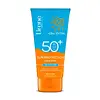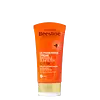What's inside
What's inside
 Key Ingredients
Key Ingredients

 Benefits
Benefits

 Concerns
Concerns

 Ingredients Side-by-side
Ingredients Side-by-side

Water
Skin ConditioningEthylhexyl Methoxycinnamate
UV AbsorberPropylene Glycol
HumectantOctocrylene
UV AbsorberC12-15 Alkyl Benzoate
AntimicrobialDimethicone
EmollientPotassium Cetyl Phosphate
EmulsifyingCetyl Alcohol
EmollientTitanium Dioxide
Cosmetic ColorantEthylhexyl Triazone
UV AbsorberButyl Methoxydibenzoylmethane
UV AbsorberHydrogenated Dimer Dilinoleyl/Dimethylcarbonate Copolymer
Emulsion StabilisingAllantoin
Skin ConditioningTocopheryl Acetate
AntioxidantBHA
AntioxidantButyrospermum Parkii Butter
Skin ConditioningSimethicone
EmollientMethylene Bis-Benzotriazolyl Tetramethylbutylphenol
UV FilterTriethanolamine
BufferingAcrylates/C10-30 Alkyl Acrylate Crosspolymer
Emulsion StabilisingXanthan Gum
EmulsifyingAlumina
AbrasiveDecyl Glucoside
CleansingStearic Acid
CleansingPalmitic Acid
EmollientMethylparaben
PreservativePhenoxyethanol
PreservativeDiazolidinyl Urea
PreservativeButylparaben
MaskingEthylparaben
PreservativePropylparaben
PreservativeWater, Ethylhexyl Methoxycinnamate, Propylene Glycol, Octocrylene, C12-15 Alkyl Benzoate, Dimethicone, Potassium Cetyl Phosphate, Cetyl Alcohol, Titanium Dioxide, Ethylhexyl Triazone, Butyl Methoxydibenzoylmethane, Hydrogenated Dimer Dilinoleyl/Dimethylcarbonate Copolymer, Allantoin, Tocopheryl Acetate, BHA, Butyrospermum Parkii Butter, Simethicone, Methylene Bis-Benzotriazolyl Tetramethylbutylphenol, Triethanolamine, Acrylates/C10-30 Alkyl Acrylate Crosspolymer, Xanthan Gum, Alumina, Decyl Glucoside, Stearic Acid, Palmitic Acid, Methylparaben, Phenoxyethanol, Diazolidinyl Urea, Butylparaben, Ethylparaben, Propylparaben
Water
Skin ConditioningOctocrylene
UV AbsorberEthylhexyl Methoxycinnamate
UV AbsorberCetyl Alcohol
EmollientGlycerin
HumectantPrunus Amygdalus Dulcis Oil
Skin ConditioningVp/Hexadecene Copolymer
Glyceryl Stearate
EmollientTitanium Dioxide
Cosmetic ColorantCera Alba
EmollientSesamum Indicum Seed Oil
EmollientCeteareth-20
CleansingLawsonia Inermis Leaf Extract
Skin ConditioningTocopheryl Acetate
AntioxidantXanthan Gum
EmulsifyingTriticum Vulgare Germ Oil
EmollientSimmondsia Chinensis Seed Oil
EmollientLactic Acid
BufferingParfum
MaskingEDTA
Water, Octocrylene, Ethylhexyl Methoxycinnamate, Cetyl Alcohol, Glycerin, Prunus Amygdalus Dulcis Oil, Vp/Hexadecene Copolymer, Glyceryl Stearate, Titanium Dioxide, Cera Alba, Sesamum Indicum Seed Oil, Ceteareth-20, Lawsonia Inermis Leaf Extract, Tocopheryl Acetate, Xanthan Gum, Triticum Vulgare Germ Oil, Simmondsia Chinensis Seed Oil, Lactic Acid, Parfum, EDTA
 Reviews
Reviews

Ingredients Explained
These ingredients are found in both products.
Ingredients higher up in an ingredient list are typically present in a larger amount.
Cetyl Alcohol is a fatty alcohol. Fatty Alcohols are most often used as an emollient or to thicken a product.
Its main roles are:
Though it has "alcohol" in the name, it is not related to denatured alcohol or ethyl alcohol.
The FDA allows products labeled "alcohol-free" to have fatty alcohols.
Learn more about Cetyl AlcoholEthylhexyl Methoxycinnamate is an organic compound that provides UVB protection. It often goes by the more common name of octinoxate. It is created from methoxycinnamic acid and 2-ethylhexanol.
Ethylhexyl Methoxycinnamate absorbs UVB rays with wavelengths between 280-320 nm. UV absorbers protect your skin by using chemical reactions to convert UV rays into heat and energy.
UVB (290-320 nm) rays emit more energy than UVA rays. They are capable of damaging DNA, causing sunburns and are thought to be linked to skin cancer.
The state of Hawaii has banned sunscreens containing octinoxate due to its potential impact on coral reefs. More research is needed to bridge gaps in this research. The European Union allows higher levels of octinoxate in sunscreens than the US and Australia.
Ethylhexyl Methoxycinnamate is oil soluble. It is not stable and may lose efficacy when exposed to sunlight.
Learn more about Ethylhexyl MethoxycinnamateOctocrylene protects skin from sun damage. It absorbs UV-B with peak absorption of 304 nm. It is a common sunscreen ingredient and often paired with avobenzone, a UVA filter. This is because octocrylene stabilizes other sunscreen ingredients by protecting them from degradation when exposed to sunlight. Octocrylene is a photostable ingredient and loses about 10% of SPF in 95 minutes.
Octocrylene also acts as an emollient, meaning it helps skin retain moisture and softens skin. It is oil-soluble and hydrophobic, enhancing water-resistant properties in a product.
Those who are using ketoprofen, a topical anti-inflammatory drug, may experience an allergic reaction when using octocrylene. It is best to speak with a healthcare professional about using sunscreens with octocrylene.
The EU allows a maximum of these concentrations:
Learn more about OctocryleneTitanium dioxide is a mineral UV filter widely used in sunscreens and cosmetics.
It is one of only two UV filters officially classified as “mineral” by regulatory agencies, the other being zinc oxide.
Titanium dioxide provides broad-spectrum protection mostly in the UVB and UVAII range, with some protection in the UVAI range.
While its UVA protection isn’t as strong as zinc oxide’s, the difference is minor.
A common myth is that mineral UV filters reflect UV light. However, modern research shows titanium dioxide absorbs UV radiation like chemical filters (~95% absorption & 5% reflection).
Thanks to its non-irritating nature, titanium dioxide is suitable for sensitive, acne-prone, or redness-prone skin. It is unlikely to cause "eye sting" like other sunscreen ingredients.
A major drawback of this ingredient is its white cast and thick texture. This is why mineral sunscreens often leave a white cast and are less cosmetically elegant than chemical/hybrid sunscreens.
To improve white cast and spreadability, micronized or nano-sized titanium dioxide is often used.
There are ongoing concerns surrounding nano-titanium oxide's impact on marine ecosystems.
There is no conclusive evidence that any form of titanium oxide (or any other sunscreen ingredients) will cause harm to marine ecosystems or coral reefs. The science is still developing but many consumers are keeping a close eye on this issue.
Please note, many destinations have reef-safety sunscreen rules. For instance, the U.S. Virgin Islands advises all visitors to use non-nano mineral sunscreens.
Nano mineral sunscreens once raised safety concerns about absorption into skin.
Extensive research has shown that they do not penetrate healthy or damaged skin; they remain safely on the surface and the top layer of dead skin (stratum corneum).
You'll likely find titanium dioxide bundled with alumina, silica, or dimethicone. These ingredients help make titanium dioxide highly photostable; this prevents it from interacting with other formula components under UV light.
Learn more about Titanium DioxideTocopheryl Acetate is AKA Vitamin E. It is an antioxidant and protects your skin from free radicals. Free radicals damage the skin by breaking down collagen.
One study found using Tocopheryl Acetate with Vitamin C decreased the number of sunburned cells.
Tocopheryl Acetate is commonly found in both skincare and dietary supplements.
Learn more about Tocopheryl AcetateWater. It's the most common cosmetic ingredient of all. You'll usually see it at the top of ingredient lists, meaning that it makes up the largest part of the product.
So why is it so popular? Water most often acts as a solvent - this means that it helps dissolve other ingredients into the formulation.
You'll also recognize water as that liquid we all need to stay alive. If you see this, drink a glass of water. Stay hydrated!
Learn more about WaterXanthan gum is used as a stabilizer and thickener within cosmetic products. It helps give products a sticky, thick feeling - preventing them from being too runny.
On the technical side of things, xanthan gum is a polysaccharide - a combination consisting of multiple sugar molecules bonded together.
Xanthan gum is a pretty common and great ingredient. It is a natural, non-toxic, non-irritating ingredient that is also commonly used in food products.
Learn more about Xanthan Gum